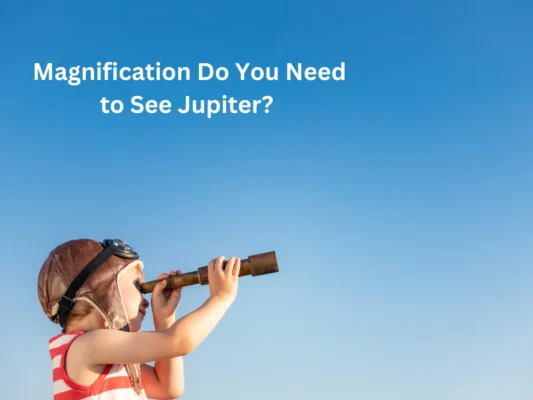Have you ever wanted to get a closer look at the planets in our solar system? Well, with the right kind of magnification, you can take a closer look at Jupiter and its four largest moons. Read on to learn more about how much magnification do you need to see Jupiter and what other equipment you should have on hand.
What Equipment Do I Need?
If you want to observe Jupiter in detail, a telescope is your best bet. A good telescope will give you higher magnification than binoculars and allow you to observe the planet’s features more clearly. The amount of magnification depends on the size of your telescope; larger telescopes provide more powerful magnification. Generally speaking, a small telescope or pair of binoculars should be enough for basic observation, while larger telescopes are needed for detailed viewing.
How Much Magnification Do You Need to see Jupiter?
The exact amount of magnification required for observing Jupiter depends on several factors, including the size of your telescope and the clarity of the night sky. For example, if you are using a small telescope with a 60mm aperture and good seeing conditions (clear skies), then 30x – 50x magnification should be enough to see details such as clouds and spots on Jupiter’s surface. If your seeing conditions are not ideal or if you’re using a larger telescope with an aperture greater than 150mm, then higher magnifications (up to 250x) may be necessary for detailed observation. It’s important to note that higher magnifications also reduce image stability due to atmospheric turbulence; this is why it’s best to use lower magnifications under less-than-ideal conditions.

Tips for Viewing Jupiter
1. Invest in a quality telescope. A quality telescope is essential if you want to spot Jupiter and other celestial bodies in detail. When purchasing a telescope, make sure to consider factors such as aperture size (the diameter of the lens or mirror) and focal length (how far away the object must be to get an image).
2. Use a star chart or astronomy app to locate Jupiter. Before attempting to view Jupiter through your telescope, use a star chart or astronomy app such as Stellarium or SkySafari to learn where in the night sky it is located. This will help you quickly find Jupiter instead of having to search for it manually with your telescope.
3. Start at low magnification and increase gradually until you find Jupiter’s disk shape and the four largest moons (Io, Europa, Ganymede, and Callisto). Depending on your particular telescope model, you may need to start at lower levels of magnification when searching for Jupiter’s disk shape and moons. If you are having trouble finding them even at low magnification levels, try increasing the power slowly until they come into focus.
4. Adjust focus until your image is clear and vivid. Once you have found Jupiter’s disk shape and moons, adjust your focus until they appear sharp and detailed on the eyepiece lens. You should also experiment with different filters so that you can better observe features such as cloud bands on Jupiter’s surface or its dark red Great Red Spot storm that appears periodically on its face.
You can check reviews of telescopes here
- Best Dobsonian Telescopes
- Best Computerized telescope
- Best Telescope for Astrophotography
- Best Dobsonian Telescope for beginners
- Best Telescope For Viewing Planets and galaxies
Conclusion:
Observing planets like Jupiter can be incredibly rewarding—and even more so when done with proper preparation! With the right equipment and knowledge about how much magnification is necessary for optimal viewing under given conditions, anyone can observe these distant worlds up close and personal! So go ahead—get yourself some gear, brush up on your astronomy basics, and start exploring the night sky!
FAQs
Q: What do I need besides a scope/binoculars?
A: To get the most out of your observations, you must have some additional equipment on hand. For example, an adjustable tripod will help keep your scope steady while observing and an eyepiece filter can help reduce glare from light pollution or moonlight when observing faint objects like planets or galaxies. Additionally, having some star charts handy can help make it easier to locate specific objects in the night sky!
Q: Can I see any details on Jupiter without using a filter?
A: Yes! Experienced astronomers have reported being able to distinguish between different cloud bands without using any additional filters; however, using filters can enhance your experience by providing clearer images with greater detail of features like the Great Red Spot storm system or individual cloud formations on its face.
Q: What type of filter should I use when viewing Jupiter?
A: The best type of filter depends on what specific features you are looking for; however, color filters are generally recommended when observing cloud bands or storms systems since they help bring out their colors more vividly than non-filtered views would allow for better contrast between areas of light and dark on its surface.
Q: Is there any way I can improve my view of other planets besides adjusting my magnification level?
A: Yes! One way to improve your view of other planets is by blocking out some light sources around them (such as nearby stars) which may be interfering with your view. This can be done by using masks over certain parts of the lens or mirror while still allowing enough light through them so that desired objects remain visible. Additionally, special high-contrast filters designed specifically for observing planetary details may also help improve overall visibility.
